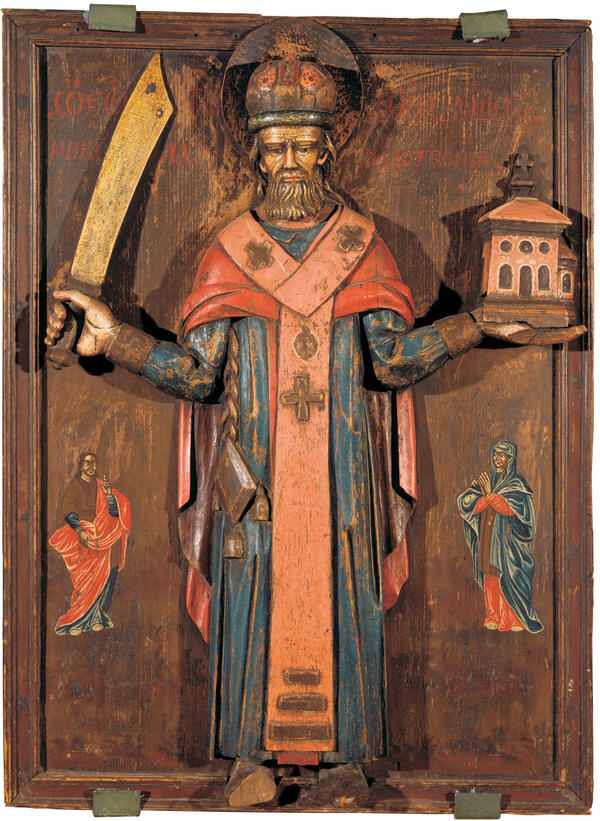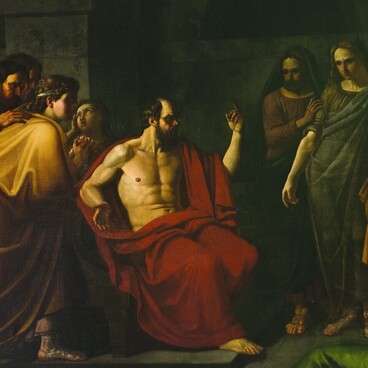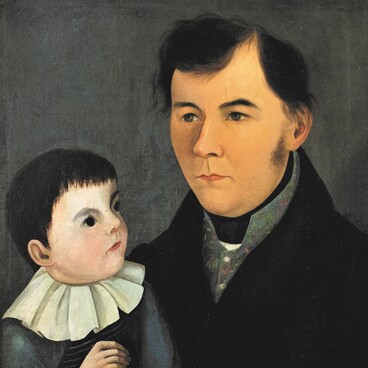One of the types of religious art dating back to the early days of Christianity was sculpture. There was a whole range of materials and forms: altar barriers and carved iconostases crowned with the Crucifixion, with the figures of angels and saints, statues and relief icons, crosses, reliquaries — arks containing the relics of saints, gravestones, copper-cast icons and folding icons.
The heyday of wooden sculpture and carved icons in Russian churches occurred at the end of the 16th — first half of the 17th centuries. At that time, relief images that came into use were somewhat flat, there was little volume, while painting was widely employed. The back of the sculpture was cut off so that it could be easily attached to an icon board or the back wall of an icon case — a glass box or cabinet for icons.
The Orthodox sculpture differed from the Catholic one in terms of the artistic techniques and the way the images were depicted. The works of Russian masters lacked the vivid expression and decorativeness of the Baroque Catholic sculptures. Orthodox images are mainly characterized by their contemplative mood, spirituality, emotional reserve and clarity.
In Russian religious sculpture, Nicholas the Wonderworker is represented as a warrior-defender. The earliest depiction of the saint is a 14th-century sculpture from the city of Mozhaysk. In his right hand, the Wonderworker holds a sword, and the model of a hexagonal fortress-city is in his left hand. Legend has it that the statue was made to commemorate the miraculous appearance of St. Nicolas of Mozhaysk, who helped save the city during the enemy attack. The saint appeared standing in the air with a sword in one hand and a church building in the other. This carved image served as a prototype for the iconography of the saint — the canonical image ‘St. Nicholas of Mozhaysk’. Now the sculpture is housed in the Tretyakov Gallery.
‘St. Nicholas of Mozhaysk’ from the museum collection belongs to a special group of ‘relief’ icons. The back of the sculpture was flattened and attached to a board. The icon was created in the 18th century in a special straight-line, sharp-relief carving technique. St. Nicholas is flanked by the Virgin and John the Theologian. Their poses remind those in the composition of ‘The Crucifixion’. This proves the special veneration of the saint in Russia.
In Siberia, the best carvers of sculptures for iconostases were the artisans from Tobolsk and Irkutsk. Until the early 20th century, there remained the examples of church decorations and carved iconostases made by local artisans in the village churches on the Angara. The collection of the Irkutsk Art Museum is one of the most significant in Eastern Siberia and includes more than 30 artifacts of the 18th — 19th centuries, that vary in style, carving techniques, and the interpretation of images.
The icon was donated to the museum by Yuri Nozhikov, the former governor of the Irkutsk region.
The heyday of wooden sculpture and carved icons in Russian churches occurred at the end of the 16th — first half of the 17th centuries. At that time, relief images that came into use were somewhat flat, there was little volume, while painting was widely employed. The back of the sculpture was cut off so that it could be easily attached to an icon board or the back wall of an icon case — a glass box or cabinet for icons.
The Orthodox sculpture differed from the Catholic one in terms of the artistic techniques and the way the images were depicted. The works of Russian masters lacked the vivid expression and decorativeness of the Baroque Catholic sculptures. Orthodox images are mainly characterized by their contemplative mood, spirituality, emotional reserve and clarity.
In Russian religious sculpture, Nicholas the Wonderworker is represented as a warrior-defender. The earliest depiction of the saint is a 14th-century sculpture from the city of Mozhaysk. In his right hand, the Wonderworker holds a sword, and the model of a hexagonal fortress-city is in his left hand. Legend has it that the statue was made to commemorate the miraculous appearance of St. Nicolas of Mozhaysk, who helped save the city during the enemy attack. The saint appeared standing in the air with a sword in one hand and a church building in the other. This carved image served as a prototype for the iconography of the saint — the canonical image ‘St. Nicholas of Mozhaysk’. Now the sculpture is housed in the Tretyakov Gallery.
‘St. Nicholas of Mozhaysk’ from the museum collection belongs to a special group of ‘relief’ icons. The back of the sculpture was flattened and attached to a board. The icon was created in the 18th century in a special straight-line, sharp-relief carving technique. St. Nicholas is flanked by the Virgin and John the Theologian. Their poses remind those in the composition of ‘The Crucifixion’. This proves the special veneration of the saint in Russia.
In Siberia, the best carvers of sculptures for iconostases were the artisans from Tobolsk and Irkutsk. Until the early 20th century, there remained the examples of church decorations and carved iconostases made by local artisans in the village churches on the Angara. The collection of the Irkutsk Art Museum is one of the most significant in Eastern Siberia and includes more than 30 artifacts of the 18th — 19th centuries, that vary in style, carving techniques, and the interpretation of images.
The icon was donated to the museum by Yuri Nozhikov, the former governor of the Irkutsk region.



